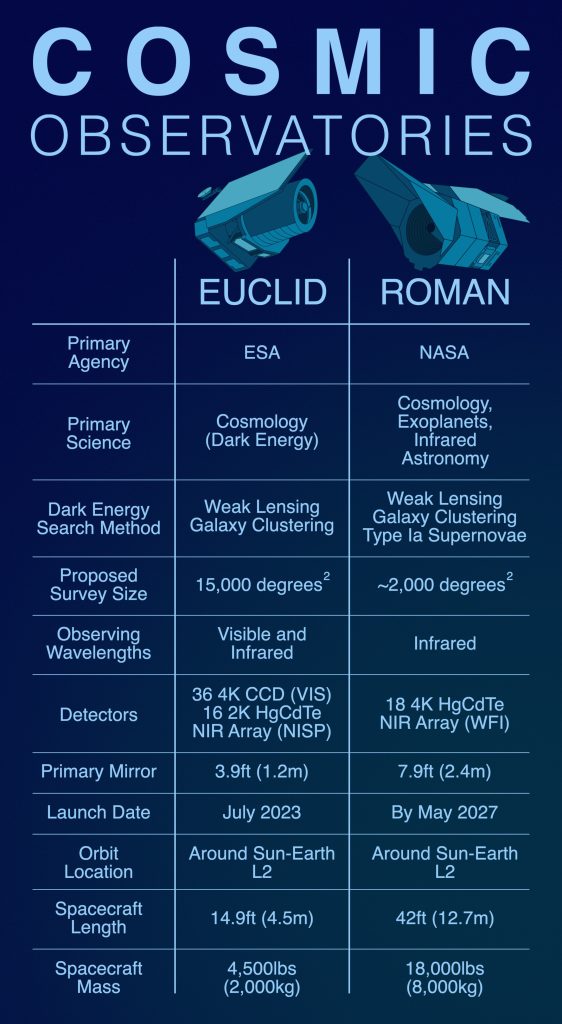NASA’s Nancy Grace Roman Space Telescope to Supplement Euclid Space Telescope’s Mission
The European Space Agency’s Euclid Space Telescope recently launched on a SpaceX Falcon 9 rocket. It will conduct a groundbreaking mission to explore the intriguing phenomenon known as dark energy, which is responsible for the accelerating expansion of the universe. This enigmatic force has puzzled scientists since evidence of its existence were first detected. In a quest for answers, Euclid will be joined by NASA’s Nancy Grace Roman Space Telescope in May 2027, presenting an unprecedented opportunity to unravel the secrets of dark energy in ways previously unimaginable.
The universe’s accelerating expansion, observed since the groundbreaking work of Belgian astronomer Georges Lemaître and Edwin Hubble in the late 1920s, remains one of astrophysics’ most perplexing mysteries. Scientists expected the gravitational pull of matter to gradually decelerate the expansion. However, observations of a specific type of supernova in the 1990s revealed an unexpected twist: dark energy emerged around 6 billion years ago, pushing the universe to expand at an accelerated pace. The implications of this discovery suggest that our current understanding of the cosmos is missing a crucial piece of the puzzle.
Why is it called the Nancy Grace Roman Space Telescope, Though?

Euclid and Roman represent two separate but complementary strategies designed to study cosmic acceleration. Euclid will observe other galaxies in an area spanning nearly 1/3 of the sky (about 15,000 square degrees) using infrared and optical light wavelengths. It is expected to reveal clues about conditions that existed in the universe 10 billion years ago.
The Nancy Grace Roman Space Telescope will observe fainter galaxies that existed up to 2 billion years ago in a region representing 1/20 of the sky, or about 2,000 square degrees. It will also be capable of detecting exoplanets in our own galaxy and study objects at the edge of our solar system.
Although the scientific missions planned for the Nancy Grace Roman Space Telescope do not focus purely on cosmology like the Euclid Space Telescope does, the data it produces can be used to supplement research conducted using Euclid. By creating more detailed and precise 3D maps of the universe, Roman and Euclid will each contribute unique streams of compelling data to answer fundamental questions about its structure and history and shed light on the mysteries of cosmic acceleration. Multiple avenues of investigation will be pursued to identify the causes behind this cosmic phenomenon.
Both Roman and Euclid can use a technique called weak gravitational lensing to study the universe’s accelerating expansion. This phenomenon occurs because mass warps the fabric of space-time, distorting the path of light passing through it. When massive galaxies or galaxy clusters act as “lenses,” objects behind them can appear distorted or create a “double vision”-like effect in which one object appears twice in an image. Even less concentrated mass, such as clumps of dark matter, can create subtler effects. By analyzing these distortions, both telescopes will generate 3D maps of dark matter, offering valuable clues about cosmic acceleration. Dark matter’s gravitational attraction acts as a cosmic glue, countering the universe’s expansion by holding galaxies and galaxy clusters together. By tallying the distribution of dark matter across cosmic time, scientists can gain a deeper understanding of the factors driving cosmic acceleration.
These two telescopes will investigate the clustering of galaxies throughout different cosmic eras. Measurements of the nearby universe have revealed a pattern in the way galaxies congregate. Presently, the likelihood of finding a galaxy about 500 million light-years away from another galaxy is roughly twice as high as finding one slightly closer or farther. Over time, the preferred distance between galaxies has increased due to the expansion of space. By observing galaxies in earlier cosmic epochs, astronomers can examine changes in the clustering patterns, revealing the expansion history of the universe. This analysis will also provide a precise test of gravity, helping to differentiate between an unknown energy component and various modified gravity theories as potential explanations for cosmic acceleration.
Roman will embark on an additional survey to discover distant type Ia supernovae, a particular type of exploding star. These supernovae exhibit a consistent intrinsic brightness, allowing astronomers to determine their distance by measuring their apparent brightness. By studying the light of these supernovae, Roman will reveal their recession velocities at different distances, effectively tracing the expansion of the universe over time. These observations will provide valuable insights into the nature of dark energy and how it has evolved throughout the history of the universe.
The surveys conducted by Roman and Euclid will overlap, with Euclid expected to observe the entire area covered by Roman. This synergy allows scientists to use Roman’s more sensitive and precise data to refine and extend corrections to Euclid’s observations across its significantly larger survey area.
The initial observations made by Euclid will inform the scientific analysis and survey strategies employed by Roman. This collaborative effort between the telescopes will provide astronomers with an enriched understanding of the universe, unraveling its mysteries with unprecedented clarity.
The Euclid mission benefits from the contributions of three NASA-supported science groups. JPL’s involvement includes the design and fabrication of Euclid’s Near Infrared Spectrometer and Photometer (NISP) instrument sensor-chip electronics, as well as the procurement and delivery of the NISP detectors, which underwent testing at NASA’s Goddard Space Flight Center. The Euclid NASA Science Center at IPAC (ENSCI), based at Caltech, will support investigations conducted within the United States that utilize Euclid’s data.





